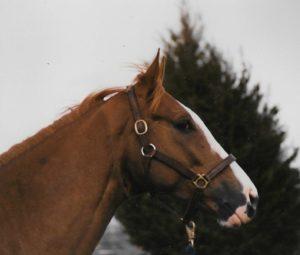The news has reached me that Tom has died. He was 33, which, while less than half the expected life of a person, was a long life indeed for a horse. And Tom was a well loved horse.
Almost thirty years ago, S D called me about a flashy four year old at the racetrack. Her mother had bred him. Mrs. D’s horses were treasured, not like the Thoroughbred racehorses we hear about who fall on hard times. This one, Just As Ordered, was a bright chestnut with chrome – four white legs and a white nose – a big, white blaze, to be precise. The old saw about cutting off his legs and throwing him to the crows would not apply. I advised, in my infinite wisdom, that she should take an offer. With those long white stockings, he would need to jump really well – poor style would be very obvious, and that is always a risk. S ignored me, and decided to have him retrained as a hunter, planning to sell him for a high price.
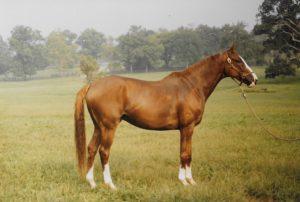
When he was a 5 year old, he came to me, after starting with another local trainer. He had a bad cold back problem, possibly related to his stifles, which locked. Now, for those of you who are not “horse people” (my mother so disapproved of people who were “horsey”!)… a “cold back” means that a horse resents the saddle when it is first put on. And “resents” means, it bucks! And if the rider has already gotten into the saddle when the cold backed horse takes issue with it, the rider is in jeopardy. “Stifles” are the equivalent to the human knee joint (we all know that all mammals have more or less the same skeletons, right? Just in slightly different configurations…). In the horse, the stifle is at the top of the hind leg – but like us, the joint has a patella, and “locking” of the stifle is upward fixation of the patella. The ligament is loose, and slips across the patella, causing the joint to stick in place, sometimes making the horse unable to move the hind leg, and snapping or jerking suddenly, when it gives way.
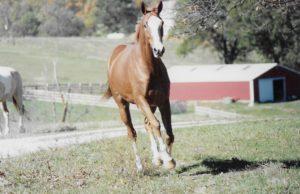
So, this chestnut Thoroughbred arrived, and he was called Tom. He was a bit rank at first, bucking dramatically around a few circles after the saddle was on, but once he was done bucking, he was nice to ride. I started jumping him, and immediately my concerns about his style were put aside. Tom was a very good jumper indeed! Perfect technique, a nice mover (meaning his gaits were pleasing to watch – and to ride). And he had a nice mouth (he was pleasant in the bridle, easy to control with the reins).
In those days, there were no “cross rail” classes. We thought it was amazing that there were classes at 2’6″, having started in an era where the lowest jumps were 3’6″. So within two weeks, Tom was showing and acquitting himself well. But he didn’t get sold – those locking stifles stood in the way.
Sadly for S, her life changed and she needed to reduce her herd. Since Tom was difficult to sell, she offered him to me as a gift. I did NOT look him in the mouth! I accepted him gladly, and there began a nearly decade long joy ride. He received a “show name” – Thomas Equinas, and many rode that moniker into memories.
Tom also foxhunted. Jane started him in the hunt field, and when Harry and I retired from riding as staff (riding at the front, or out on our own), Tom became Harry’s hunt horse. He was a delightful horse to ride “in the field” (in the group of riders following the Master of Foxhounds) – and he and Harry were a handsome pair!
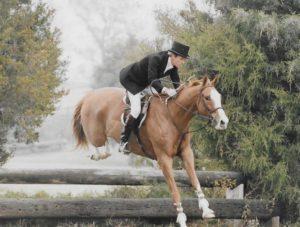
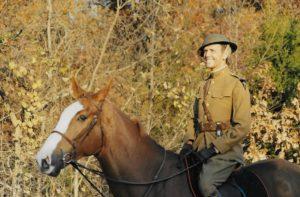
Jane showed Thomas Equinas as a First Year Green Hunter when her horse was injured.  He was equally talented as a hunter or a jumper (again, for the non horse people, if any of you are still reading – “hunters” are judged on style, “jumpers” jump higher and go faster. There is much more to it than that, but it’s not relevant here…). Tom could jump a big jump, turn on a dime (and, yes, give you a nickel change) and he was fairly brave – but he could be a bit of a spook, which played well in the hunters, giving him an expressive jump to go with his impeccable form (the way he lifted his long, white legs over the jumps). So, he was a lot of fun, and he soon partnered with Harry as a show horse, Harry having given him his much loved title of Thomas Equinas.
He was equally talented as a hunter or a jumper (again, for the non horse people, if any of you are still reading – “hunters” are judged on style, “jumpers” jump higher and go faster. There is much more to it than that, but it’s not relevant here…). Tom could jump a big jump, turn on a dime (and, yes, give you a nickel change) and he was fairly brave – but he could be a bit of a spook, which played well in the hunters, giving him an expressive jump to go with his impeccable form (the way he lifted his long, white legs over the jumps). So, he was a lot of fun, and he soon partnered with Harry as a show horse, Harry having given him his much loved title of Thomas Equinas.
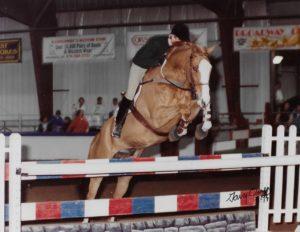
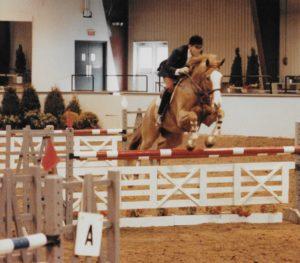
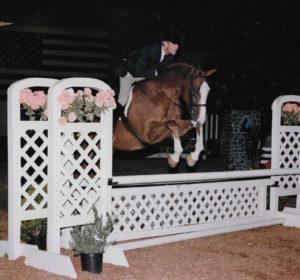
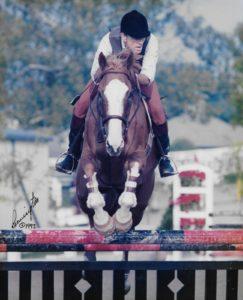
They were a great team. Harry loved to go fast, and Tom could certainly do that. Diane Carney schooled them to the win in the NAL Classic in Kentucky 1993, a class so exciting that Diane sent me away for being too nervous. We still have the white wool cooler (horse blanket), a most treasured win. Todd Minikus, too, schooled Harry and Thomas Equinas to successes in the Amateur Owner Jumpers (very big jumps). And occasionally, I, too, got to show Tom in the AO Jumpers.
Then, since we were in the business of selling horses, Thomas Equinas was sold to B K, who was a top midwest amateur rider at the time. She gave Tom great rides and showed him as a hunter, a jumper AND an equitation horse (non horse people – “equitation” judges the rider, but requires a well trained horse with scope – the ability to make the difficult look easy).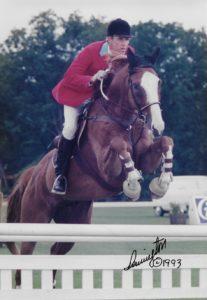
From B K, Tom went on to Skip and Anne Thornbury, and then to Richard Rinehart in Indiana, and continued to be successful over lower jumps, as now he was getting “old”, in that he was approaching 20. Wherever he went, he was loved. We were so happy at horse shows to meet people who treasured Tom, as he deserved.
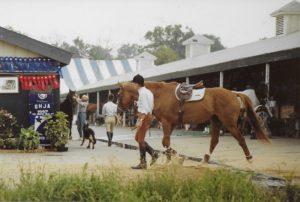
And then, Thomas Equinas returned to Missouri, to William Woods University. In his twenties, under the excellent care of Linda McClaren, he won state championships in the Beginner Hunters (beginner riders) for several years. He thrived at the University equestrian program, and when he began to get “really” old, he went to Kentucky, where he was rechristened “Saint” (as a nod to Thomas Aquinas) and began to teach little children. He died yesterday after many good years in the bluegrass, where countless great Thoroughbreds have been laid to rest. Many will grieve his passing, as Harry and I did , when we learned that his long run was over.
Thomas Equinas was a great Thoroughbred, in stature and in soul. He cribbed for the entire 33 years of his life. He pulled many shoes from those big, white feet, with his short back and extravagant overstep. He introduced us to veterinary “maintenance” of horses – joint injections. His stifles snapped and popped for his entire career. His cold back lasted only a couple of weeks, before he decided it was too much work to buck, and a waste of energy. He was loved by everyone who rode him and cared for him – he was a real gentleman, and I can never thank S D enough for the gift of that great horse. Tears were shed today, for days gone by, and in gratitude for a long, well loved life. Gallop through, Tom.
